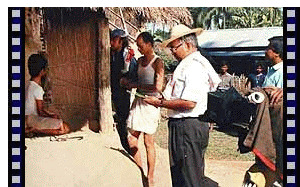Magic on the Screen
Bhabendranath Saikia: 25 Years of Film Making
by Sultan Ali Ahmed
Fouzdaripatti. A well-known area within the Nagaon town. The area comes under the jurisdiction of the municipality, but the road into the area is not pitched. A water tanker comes frequently to water the road so that the dust level is minimised. As and when the tanker comes, little boys of the area begin their action, they chase the vehicle and wash their hands using the water from the long pipe. Very often, the driver or other municipality workers rebuke the little boys. They flee the scene only to resurface again.
 This, and other kinds of jovial moments are part and parcel of childhood. But, very few persons have been able to express these in a very lucid style, in an honest way, that too as a part of their autobiography. Among these very few, one is Dr Bhabendra Nath Saikia — story writer, novelist, filmmaker, student of science, researcher, physicist, editor — all rolled into one. This, and other kinds of jovial moments are part and parcel of childhood. But, very few persons have been able to express these in a very lucid style, in an honest way, that too as a part of their autobiography. Among these very few, one is Dr Bhabendra Nath Saikia — story writer, novelist, filmmaker, student of science, researcher, physicist, editor — all rolled into one.
Dr Saikia is a unique name as far as Assamese film-making is concerned. It was on August 5, 1977 — exactly 25 years ago — when his first film Sandhyaraag was released. The creator of Sandhyaraag himself has acknowledged that it was just to fulfil a long-pending desire that he made the film. Twenty-five years ago, many others also assumed that for Dr Saikia, Sandhyaraag was ‘this far and no further’. However, proving everyone wrong, the filmmaker delivered eight beautiful, serious, artistic films till this date. The last 25 years have witnessed a simple desire turning into a serious passion — the love for art.
From Sandhyaraag in 1977 to Kalsandhya in 1999, this man has not only churned out eight films, but also established the fact that even without a conducive environ-ment for filmmaking in the State, good films can be made. He has been credited, by friends and foes alike, with the distinction of taking the Assamese film movement to the national and international levels. And, Dr Saikia has done this almost single handedly.
His first film Sandhyaraag created a record, being the first Assamese film to be included in the Indian Panorama section of the International Film festival of India. There was no looking back after that, and the maestro’s works almost monopolised the state film industry as far as inclusions in the Indian Panorama were concerned. Except Anirbaan in 1981, all the other films went for the Indian Panorama section of the International Film Festival of India.
The most exclusive aspect of Dr Saikia’s filmmaking is that each of his films was based on his own stories. While Sandhyaraag was an expanded version of his short story Banaprastha, Anirbaan was based on Prahari. Agnishnan, the master stroke of the maestro, was a concise version of his famous novel Antarip, while Kolahal was the celluloid version of short story Endur. Foundation, the story led to the screenplay of Sarothi, while Abartan was an exclusive for the film. Barnana was the story basing upon which Dr Saikia made Itihaas. Kalsandhya, his only attempt in Hindi, was his own story.
All the Assamese films by Dr Saikia bagged the prestigious Rajat Kamal Award as the best regional film — Sandhyaraag in 1978, Anirbaan in 1981, Agnishnan in 1985, Kolahal in 1988, Sarothi in 1992, Abartan in 1994 and Itihaas in 1996. Besides this, Dr Saikia won the national award for best screenplay for Agnishnan. His films have been shown in different international film festivals held at Chennai, Hyderabad, New Delhi, Bangalore, Kolkata, Carlovi Vary (Czechoslovakia), Nantis (France), Valladolid (Spain), Algiers (Algeria), Pyong Yang (North Korea), Sydney, Munich, Montreal and Toronto.
Almost all his films have depicted the true life of the commoners, their hopes and despair, dreams and night-mares, values and morals, struggle for a survival, both physically and intellectually, individual as well as social obligations, and many more.
 The boldness with which Dr Saikia established the independence of a woman’s inner self in Agnishnaan was not only a trendsetter, but also was an example of cinematic expertise. His style of exploit of a character in the silverscreen has remained enviable for many of his successors. His fifth Sarothi has been credited as a reflection of his microscopic observation of the mindsets of the middle-class. Dr Saikia’s ability to express the most complex thought in a most lucid way is the hallmark of his filmmaking. Like all his writings, stories and novels, each of his films is gifted with the abundance of detailing. Many of his critics are of the opinion that it has been his acumen to see things in a minute way which has brought success to all of his works. The boldness with which Dr Saikia established the independence of a woman’s inner self in Agnishnaan was not only a trendsetter, but also was an example of cinematic expertise. His style of exploit of a character in the silverscreen has remained enviable for many of his successors. His fifth Sarothi has been credited as a reflection of his microscopic observation of the mindsets of the middle-class. Dr Saikia’s ability to express the most complex thought in a most lucid way is the hallmark of his filmmaking. Like all his writings, stories and novels, each of his films is gifted with the abundance of detailing. Many of his critics are of the opinion that it has been his acumen to see things in a minute way which has brought success to all of his works.
In his films, Saikia seldom used songs which were out of turn. In fact, except Kolahal and Sandhyaraag, none of his films have songs in their course. For this, he feels that it should be the background music which ought to give an even pace to any kind of celluloid story-telling.
Except Sarothi in 1991, all other films revolved around a woman’s character, thus rendering his films woman-oriented, at least thematically. The maestro has acknowledged that women have been a source of inspiration, both in their bold and weak versions. And, as his writings have expressed his feelings towards this ‘so-called’ weaker sex, so have done his films.
 In Kalsandhya (Twilight of Death), Dr Saikia selected a rather controversial theme — insurgency in this part of the country. Kalsandhya was screened at the Indian Panorama section of the International Film Festival of India, New Delhi in 1998. The film was also a part of the Indian section in the Cairo International Film Festival in 1999. Dr Saikia, as an exceptionally fine exhibitor of a story, projected the immediate need for introspection by every individual of our society who is directly or indirectly, compelled to be involved in this completely uncertain and chaotic situation. Wishing a complete ban on the insurgent activities in the region, Kalsandhya has brought to the foreground the futility of such inhumane exercises by the youths misled by a sudden upsurge of emotion vis-a-vis any changes for the ‘betterment’ of our society. Dr Saikia’s first Hindi film Kalsandhya was a presentation of a bold face to insurgency. In Kalsandhya (Twilight of Death), Dr Saikia selected a rather controversial theme — insurgency in this part of the country. Kalsandhya was screened at the Indian Panorama section of the International Film Festival of India, New Delhi in 1998. The film was also a part of the Indian section in the Cairo International Film Festival in 1999. Dr Saikia, as an exceptionally fine exhibitor of a story, projected the immediate need for introspection by every individual of our society who is directly or indirectly, compelled to be involved in this completely uncertain and chaotic situation. Wishing a complete ban on the insurgent activities in the region, Kalsandhya has brought to the foreground the futility of such inhumane exercises by the youths misled by a sudden upsurge of emotion vis-a-vis any changes for the ‘betterment’ of our society. Dr Saikia’s first Hindi film Kalsandhya was a presentation of a bold face to insurgency.
Development of a character has been the most significant aspect of Dr Saikia’s style of celluloid story-telling. He has been able to picturise each and every of his characters with due importance, without any jerks or hassles. He has not discriminated any of his characters, was never biased towards any of them. As a creator, he has been able to give a neutral stand and an equal treatment towards all his characters, which are, in fact, versions of the common individuals of our society.
As an individual, Dr Bhabendra Nath Saikia has set examples. So has the filmmaker. His kind of filmmaking has a unique style — simple yet versatile, subtle yet bold, individual yet intellectual. Envied by many, the filmmaker in Dr Saikia has single handedly changed the face of Assamese filmmaking, which is serious and beautiful, artistic and aesthetic, all at the same time. Today, Dr Bhabendra Nath Saikia has completed 25 long years of filmmaking — Sandhyaraag was released exactly 25 years ago on August 5, 1997. During these 25 glorious years, Dr Saikia has remained one of the finest celluloid adventurers, highly-acclaimed, well-critcised by people who mattered. What he has given to Assam and its people through his eight films is second to none. So is the case with Dr Saikia, the individual. He is a rare breed of filmmaker, in a class of his own. We fervently wish for more such grand works from the maestro. Happy silver jubilee!

Courtesy: The Assam Tribune (2002)
Read more about Dr Saikia.
Read Dr Saikia's short stories.

|
